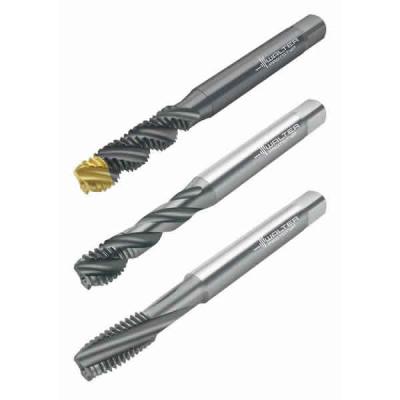
Walter has introduced the TC120, TC121 and TC122 Supreme, three new blind-hole taps that combine maximum performance in steel with improved tool life and process reliability. These new entries in the Walter Supreme line have been specially developed for machining steel. The taps cover all tensile strengths from 43-200 kpsi.
The TC120 Supreme with a 45° helix angle makes it possible to reliably produce threads up to 3 × DN in soft and medium-strength steels (ISO P, N). It stands out due to its partial TiN coating in the chamfer section which increases wear resistance and tool life, special geometry, good chip evacuation and an extra-long threaded section that results in significantly less fracturing in the guide section. It is available with internal cooling for improved chip evacuation.
The TC121 Supreme tap is suitable for threads up to 2.5 × DN in steels with medium tensile strengths between 112-177 kpsi (ISO P, M, K, N). The tap features a 40° helix angle and a geometry which ensures tightly rolled chips, TiAIN or TiCN coating, and combines maximum performance in steel in the medium strength range and maximum tool life with a high level of process reliability, with internal cooling for improved chip control.
The TC122 Supreme with a 15° helix angle ensures a long tool life in medium- to high-strength ISO steel and cast-iron materials. It can produce thread depths up to 1.5 × DN without internal cooling, while up to 2.5 × DN is possible with internal cooling. Internal cooling increases process reliability by flushing out the chips. This hardened tap features a special geometry for extremely short chips, as well as a TiCN coating.
As a package, the three taps offer benefits for users who want to machine a wide range of steels, for example, in general metalworking.
Contact Details
Related Glossary Terms
- blind-hole
blind-hole
Hole or cavity cut in a solid shape that does not connect with other holes or exit through the workpiece.
- helix angle
helix angle
Angle that the tool’s leading edge makes with the plane of its centerline.
- metalworking
metalworking
Any manufacturing process in which metal is processed or machined such that the workpiece is given a new shape. Broadly defined, the term includes processes such as design and layout, heat-treating, material handling and inspection.
- tap
tap
Cylindrical tool that cuts internal threads and has flutes to remove chips and carry tapping fluid to the point of cut. Normally used on a drill press or tapping machine but also may be operated manually. See tapping.
- titanium carbonitride ( TiCN)
titanium carbonitride ( TiCN)
Often used as a tool coating. See coated tools.
- titanium nitride ( TiN)
titanium nitride ( TiN)
Added to titanium-carbide tooling to permit machining of hard metals at high speeds. Also used as a tool coating. See coated tools.
- wear resistance
wear resistance
Ability of the tool to withstand stresses that cause it to wear during cutting; an attribute linked to alloy composition, base material, thermal conditions, type of tooling and operation and other variables.

